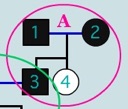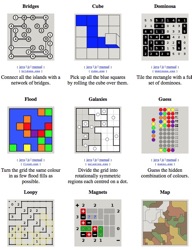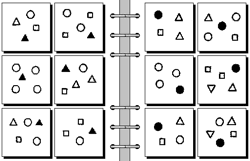If we look at problem-solving as “figuring out something truly novel” as opposed to “grinding out an answer  using different insertions for the variables”, the game gets much more complicated… and there’s a lot more to ‘teach’ and to discover. I’ve posted a number of different “derived wisdoms” elsewhere (Polya, me, thinkBio’s problem-solving games directory), now I want to highlight a specific example about a general principle: “The way represent a problem defines the answers we can come up with.” Take the famous figure on the right. If presented as “Look at the black images; what do you see?” most come up with a pair of faces. If asked “What is depicted in white?” you see the goblet. The derived challenges are: how do we make sure we cast problems correctly? and how do you ‘unsee’ an initial finding? Continue reading
using different insertions for the variables”, the game gets much more complicated… and there’s a lot more to ‘teach’ and to discover. I’ve posted a number of different “derived wisdoms” elsewhere (Polya, me, thinkBio’s problem-solving games directory), now I want to highlight a specific example about a general principle: “The way represent a problem defines the answers we can come up with.” Take the famous figure on the right. If presented as “Look at the black images; what do you see?” most come up with a pair of faces. If asked “What is depicted in white?” you see the goblet. The derived challenges are: how do we make sure we cast problems correctly? and how do you ‘unsee’ an initial finding? Continue reading
Problem solving strategies
Plea for pedigrees: pedigree deduction in Introductory Biology
 Pedigree-solving can be perceived as passé in an era in which every single nucleotide of an individual’s genome can be learned (relatively) affordably, parents be damned. But I don’t think that’s the value in teaching pedigree deduction; indeed, I question whether it ever should have been. As with many exercises in Introductory Biology, I think we need to make careful distinctions between means and ends. Pedigree deduction can be employed as one of a class of near-perfect problem-solving opportunities, employing limited, easy-to-grasp tools, reflecting core biology (meiosis, randomness), and representing an unforgiving series of clear deductions. To my mind, the question should be how do we make sure these aspects are represented in tasks and assessments involving pedigrees.
Pedigree-solving can be perceived as passé in an era in which every single nucleotide of an individual’s genome can be learned (relatively) affordably, parents be damned. But I don’t think that’s the value in teaching pedigree deduction; indeed, I question whether it ever should have been. As with many exercises in Introductory Biology, I think we need to make careful distinctions between means and ends. Pedigree deduction can be employed as one of a class of near-perfect problem-solving opportunities, employing limited, easy-to-grasp tools, reflecting core biology (meiosis, randomness), and representing an unforgiving series of clear deductions. To my mind, the question should be how do we make sure these aspects are represented in tasks and assessments involving pedigrees.
Visible thinking: logic diagrams as science student tasks
I have been frustrated with challenges associated with sloppy student thinking on the one hand and the challenge of detecting/understanding student logic in verbal work on the other. I think the challenge is twofold: part is in finding ways to help them organize their thoughts (and create/detect organization); part is driving a ‘common language’ where the structure of their ideas stands out from the word-swamp that a lab report or textual description can be. In several classes, colleagues and I have used ‘logic diagrams’ and after climbing the learning curve, I think we see students achieving mastery resulting in better thinking, more insightful and well-organized final products, and quicker, easier grading–that directly addresses (our) assignment goals. Disclaimer: personal story, examples & perceptions, not studies, follow.
Tatham Puzzle Collection: problem solving strategies
 To my mind, there are two phases to a lot of classical ‘logic puzzles’. Take Sudoku (spoiler alert! Problem solving strategies already developed & revealed 🙁 ), for example. There is an initial phase where you figure out how to win; then you can play an infinite number of ‘success oriented’ games where you implement the strategies you developed initially, but rarely or never develop more. I think the initial phase holds the rich opportunities for giving folks an opportunity to develop their problem-solving skills in a meta-cognitive way. So, alongside Petals around the Rose, Bongard Problems, and PatternMaster, I’m linking to Simon Tatham’s Puzzle Collection because it hosts a variety of different problems. Not with the goal of allowing everyone an opportunity to play the one they like, but to explore and learn the ‘tricks’ of some that are unfamiliar.
To my mind, there are two phases to a lot of classical ‘logic puzzles’. Take Sudoku (spoiler alert! Problem solving strategies already developed & revealed 🙁 ), for example. There is an initial phase where you figure out how to win; then you can play an infinite number of ‘success oriented’ games where you implement the strategies you developed initially, but rarely or never develop more. I think the initial phase holds the rich opportunities for giving folks an opportunity to develop their problem-solving skills in a meta-cognitive way. So, alongside Petals around the Rose, Bongard Problems, and PatternMaster, I’m linking to Simon Tatham’s Puzzle Collection because it hosts a variety of different problems. Not with the goal of allowing everyone an opportunity to play the one they like, but to explore and learn the ‘tricks’ of some that are unfamiliar.
Bongard Problems: Quickie Scientific Method
 Bongard problems are an interesting way to challenge students to make discoveries using problem solving methods. An example (from the site linked at the beginning of this post) is shown below (hit ‘More’). All the Bongard problems have the same underlying premise: the group of six image/object collections on the left are united by some principle that is present in none of the six collections on the right. While it’s easy and fun to simply play this as a game, it’s another example of ‘discovery science’ based puzzle activities a la Petals Around the Rose or PatternMaster.
Bongard problems are an interesting way to challenge students to make discoveries using problem solving methods. An example (from the site linked at the beginning of this post) is shown below (hit ‘More’). All the Bongard problems have the same underlying premise: the group of six image/object collections on the left are united by some principle that is present in none of the six collections on the right. While it’s easy and fun to simply play this as a game, it’s another example of ‘discovery science’ based puzzle activities a la Petals Around the Rose or PatternMaster.
PatternMaster: Real Scientific Method
Sitting in a classroom, a beginning biology student can easily come away with the impression that the Joy of Science lies in memorizing what is already known… and that historical problem solving and experimentation was about confirming what was obvious or inevitable. This describes no one I have ever worked with, and no lab I’ve ever worked in. The challenge is in delivering the excitement of figuring things out; too many labs are about taking (often stale) data.
PatternMaster (now playable via web/tablet!) lets students make discoveries about how things work using the Scientific Method. To quote the NGSS ‘Crosscutting concepts’:
1. Patterns. Observed patterns of forms and events guide organization and classification, and they prompt questions about relationships and the factors that influence them.

